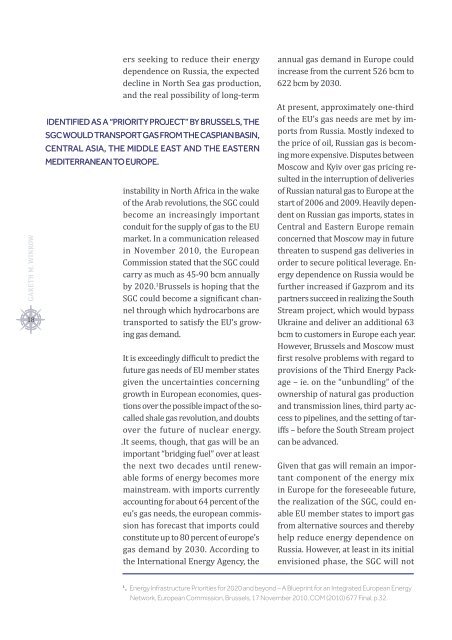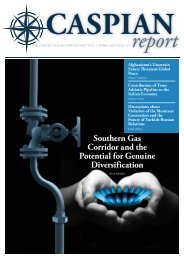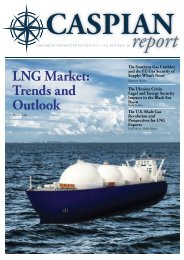Caspian Report - Issue 06 - Winter 2014
Create successful ePaper yourself
Turn your PDF publications into a flip-book with our unique Google optimized e-Paper software.
GARETH M. WINROW<br />
18<br />
ers seeking to reduce their energy<br />
dependence on Russia, the expected<br />
decline in North Sea gas production,<br />
and the real possibility of long-term<br />
IDENTIFIED AS A “PRIORITY PROJECT” BY BRUSSELS, THE<br />
SGC WOULD TRANSPORT GAS FROM THE CASPIAN BASIN,<br />
CENTRAL ASIA, THE MIDDLE EAST AND THE EASTERN<br />
MEDITERRANEAN TO EUROPE.<br />
instability in North Africa in the wake<br />
of the Arab revolutions, the SGC could<br />
become an increasingly important<br />
conduit for the supply of gas to the EU<br />
market. In a communication released<br />
in November 2010, the European<br />
Commission stated that the SGC could<br />
carry as much as 45-90 bcm annually<br />
by 2020. 1 Brussels is hoping that the<br />
SGC could become a significant channel<br />
through which hydrocarbons are<br />
transported to satisfy the EU’s growing<br />
gas demand.<br />
It is exceedingly difficult to predict the<br />
future gas needs of EU member states<br />
given the uncertainties concerning<br />
growth in European economies, questions<br />
over the possible impact of the socalled<br />
shale gas revolution, and doubts<br />
over the future of nuclear energy.<br />
.It seems, though, that gas will be an<br />
important “bridging fuel” over at least<br />
the next two decades until renewable<br />
forms of energy becomes more<br />
mainstream. with imports currently<br />
accounting for about 64 percent of the<br />
eu’s gas needs, the european commission<br />
has forecast that imports could<br />
constitute up to 80 percent of europe’s<br />
gas demand by 2030. According to<br />
the International Energy Agency, the<br />
annual gas demand in Europe could<br />
increase from the current 526 bcm to<br />
622 bcm by 2030.<br />
At present, approximately one-third<br />
of the EU’s gas needs are met by imports<br />
from Russia. Mostly indexed to<br />
the price of oil, Russian gas is becoming<br />
more expensive. Disputes between<br />
Moscow and Kyiv over gas pricing resulted<br />
in the interruption of deliveries<br />
of Russian natural gas to Europe at the<br />
start of 20<strong>06</strong> and 2009. Heavily dependent<br />
on Russian gas imports, states in<br />
Central and Eastern Europe remain<br />
concerned that Moscow may in future<br />
threaten to suspend gas deliveries in<br />
order to secure political leverage. Energy<br />
dependence on Russia would be<br />
further increased if Gazprom and its<br />
partners succeed in realizing the South<br />
Stream project, which would bypass<br />
Ukraine and deliver an additional 63<br />
bcm to customers in Europe each year.<br />
However, Brussels and Moscow must<br />
first resolve problems with regard to<br />
provisions of the Third Energy Package<br />
– ie. on the “unbundling” of the<br />
ownership of natural gas production<br />
and transmission lines, third party access<br />
to pipelines, and the setting of tariffs<br />
– before the South Stream project<br />
can be advanced.<br />
Given that gas will remain an important<br />
component of the energy mix<br />
in Europe for the foreseeable future,<br />
the realization of the SGC, could enable<br />
EU member states to import gas<br />
from alternative sources and thereby<br />
help reduce energy dependence on<br />
Russia. However, at least in its initial<br />
envisioned phase, the SGC will not<br />
1<br />
. Energy Infrastructure Priorities for 2020 and beyond – A Blueprint for an Integrated European Energy<br />
Network, European Commission, Brussels, 17 November 2010, COM (2010) 677 Final, p.32.










